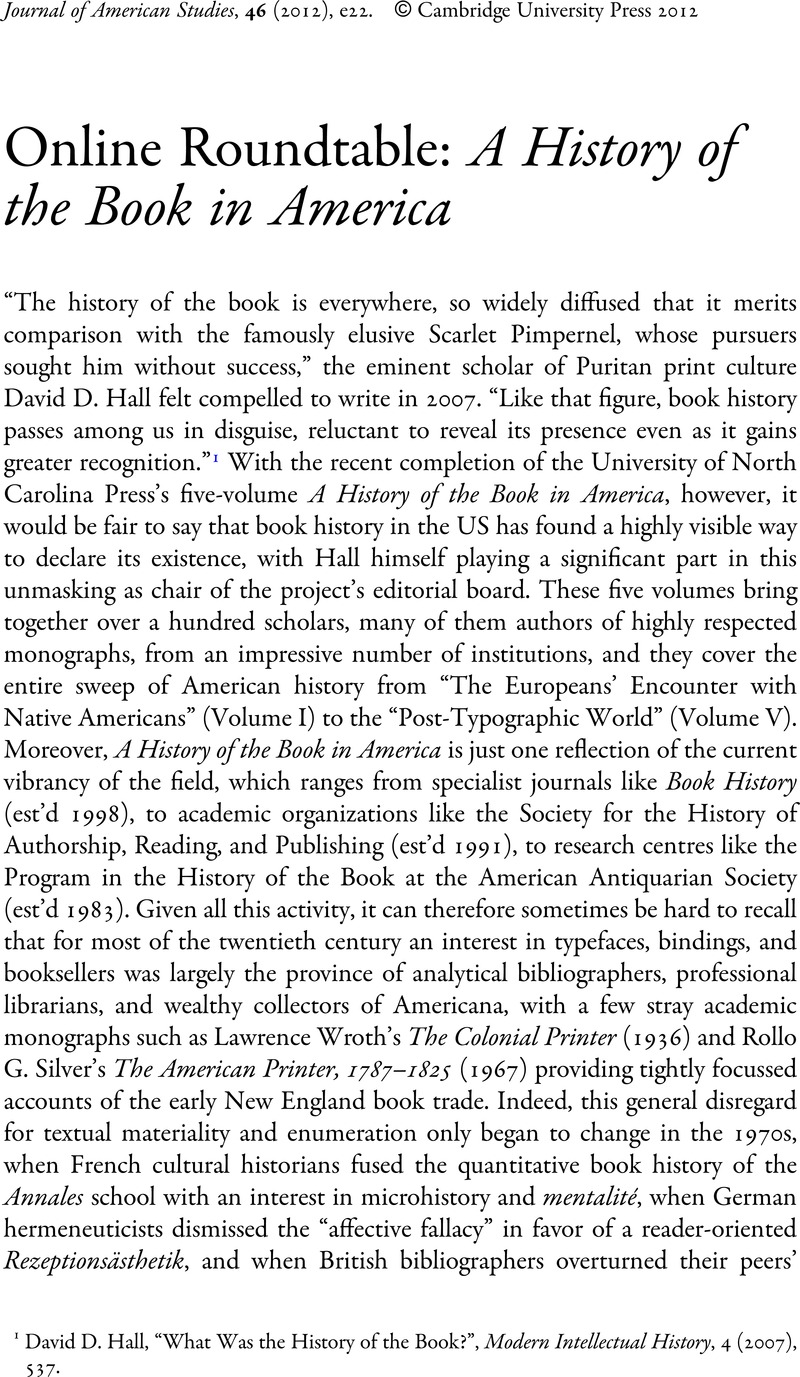No CrossRef data available.
Article contents
Online Roundtable: A History of the Book in America
Published online by Cambridge University Press: 30 May 2012
Abstract
An abstract is not available for this content so a preview has been provided. Please use the Get access link above for information on how to access this content.

- Type
- Round Table
- Information
- Copyright
- Copyright © Cambridge University Press 2012
References
Hall, David D., “What Was the History of the Book?”, Modern Intellectual History, 4 (2007), 537CrossRefGoogle Scholar
Finkelstein, David and McCleery's, AlistairAn Introduction to Book History (New York: Routledge, 2005), 7–27Google Scholar
Rubin's, Joan Shelley “What Is the History of the History of Books?”, Journal of American History, 90 (2003), 555–75CrossRefGoogle Scholar
Hall, David D., “Some Contexts and Questions,” A History of the Book in America, Volume I, The Colonial Book in the Atlantic World, ed. Hugh Amory and David D. Hall (Chapel Hill: University of North Carolina Press, 2007), 13Google Scholar
de Certeau, Michel, The Practice of Everday Life, trans. Steven Rendall (Berkeley: University of California Press, 1984), xivGoogle Scholar
Gustafson, Sandra, Eloquence Is Power: Oratory and Performance in Early America (Chapel Hill: University of North Carolina Press, 2000), xivGoogle Scholar
Cohen, Matt, The Networked Wilderness: Communicating in Early America (Minneapolis: University of Minnesota Press, 2010), 12Google Scholar
Wyss, Hilary, Writing Indians: Literacy, Christianity, and Native Community in Early America (Amherst: University of Massachusetts Press, 2000), 50Google Scholar
Brooks, Lisa, The Common Pot: Indigenous Writings and the Reconstruction of Native Space in the Northeast (Cambridge, MA: Harvard University Press, 2009), 11Google Scholar
McHenry, Elizabeth, Forgotten Readers: Recovering the Lost History of African American Literary Societies (Durham, NC: Duke University Press, 2002)CrossRefGoogle Scholar
Jackson, Leon, The Business of Letters: Authorial Economies in Antebellum America (Stanford: Stanford University Press, 2008), 2Google Scholar
Warner, Michael, The Letters of the Republic: Publication and the Public Sphere in Eighteenth-Century America (Cambridge, MA: Harvard University Press, 1990), xiiGoogle Scholar
Kelley, Mary, Learning to Stand and Speak: Women, Education, and Public Life in America's Republic (Chapel Hill: University of North Carolina Press, 1996)Google Scholar
Brooks, Joanna, “The Early American Public Sphere and the Emergence of a Black Print Counterpublic,” William and Mary Quarterly, 62 (2005), 67–98CrossRefGoogle Scholar
Davidson, Cathy N., Revolution and the Word: The Rise of the Novel in America (New York: Oxford University Press, 1986)Google Scholar
Loughran, Trish, The Republic in Print: Print Culture in the Age of U.S. Nation Building, 1770–1870 (New York: Columbia University Press, 2007), xixGoogle Scholar
McGill, Meredith L., American Literature and the Culture of Reprinting, 1834–1853 (Philadelphia: University of Pennsylvania Press, 2002)Google Scholar
Henkin, David, City Reading: Written Words and Public Spaces in Antebellum New York (New York: Columbia University Press, 1998)Google Scholar
Rubin, Joan Shelley, “What Is the History of the History of Books?” Journal of American History, 90 (2003), 555–56CrossRefGoogle Scholar
Lears, T. J. Jackson, No Place of Grace: Antimodernism and the Transformation of American Culture, 1880–1920 (Chicago: University of Chicago Press, 1994), 5–7Google Scholar
Saab, A. Joan, For the Millions: American Art and Culture in the 1930s (Philadelphia: University of Pennsylvania Press, 2004), 2Google Scholar
Hemingway, Andrew, “Cultural Democracy by Default: The Politics of the New Deal Arts Programmes,” Oxford Art Journal, 30, 2 (2007), 269–87CrossRefGoogle Scholar
Wilson, Christopher, The Labor of Words: Literary Professionalism in the Progressive Era (Athens: University of Georgia Press, 1985), xiGoogle Scholar
Greco, Albert N., Rodriguez, Clara E., and Wharton, Robert M., The Culture and Commerce of Publishing in the 21st Century (Stanford: Stanford University Press, 2007), 30Google Scholar


